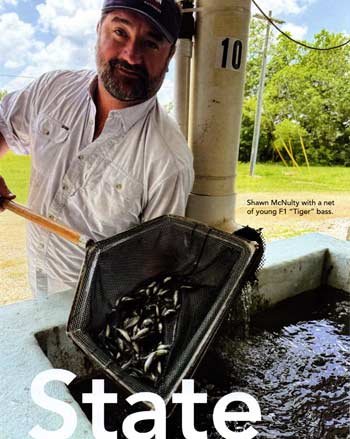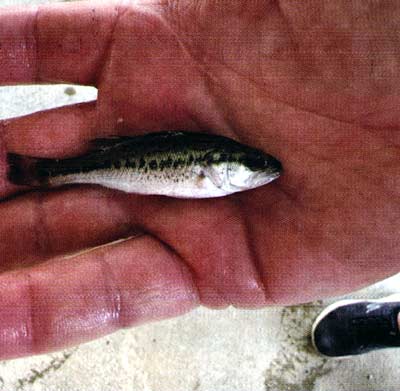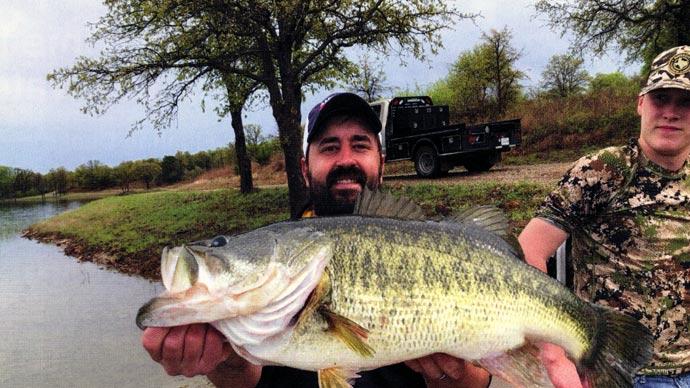
Over the last few years, there have been more than a few murmurs about the genetics of Largemouth bass.
One outfit along the eastern seaboard has claimed to have cracked the code on the finer points of formerly unidentified genetic markers that only the biggest bass carry. Up until now, genetic testing of bass has been relatively unsophisticated.
That outfit in the southeast sells their bass babies for $5.00 if you can get them to return a phone call.
Another outfit in Texas claimed fame with their numerous double-digit bass for almost a dozen years. They're now in Year 16, and social media doesn't bless us with much news about them. I suspect their biggest bass have faded out with age and the subsequent generations haven't been big enough fodder to hear amongst bass squeezers online.
Fisheries biologist Ike Perkins, wildlife and fisheries manager for the Regalo Ranch, near Catarina, in deep south Texas, made this observation. "Growing up in the cattle business, it's common knowledge that cattlemen know enough about genetic markers of their livestock where they can breed for specific qualities of cattle, to meet their needs and the needs of their marketplace." He added, "Same in the horse industry." Without blinking, and with more than a touch of passion, he closed with this, "Same in the deer industry. We can breed deer for antler growth and antler symmetry, using similar principles as livestock producers."
He also said advances are being made to genetically avoid Chronic Wasting Disease, one of today's biggest political and pathological issues in the national deer industry.
Talking with Steve "Big 0" Parks, a rabid bass angler and grower of big fish and huge deer, added another crucial genetic point. "I'm raising deer with huge antlers, and they need genetics to have a heavy body weight. Some of those deer will have to hold up antlers in velvet that can weigh up to forty or fifty pounds."
Those different disciplines have homed in on specific genetic traits for specific reasons.
Why not bass?
After that spirited conversation with Ike and ranch owner David Little, it made me want to dig a little deeper into the science and progress of the genetic study of Largemouth bass.
I called Tom Lang, Director of the Texas Parks and Wildlife Department's Freshwater Fisheries Center in Athens, Texas, home of the nationally famous Sharelunker program. Anglers across the state have the opportunity to donate or lend a huge bass during a springtime window. Those 13-pound-plus bass are quickly picked up by staff from the lake, where they were caught by legal means, brought to the hatchery, treated with care, and prepped for spawning.

Biologists clip a fin and send it straight away to the TPWD lab for genetic testing. If it tests pure Florida (whatever that means..., the best I can learn is it tests at least 97% Florida), then it's used for spawning what the state exclusively calls "Lone Star" bass.
Lang noted that all those 13-pound-plus bass are spawned, regardless of percentage. From a fisheries biologist's point of view, Lang said, "There are several interesting things about these huge fish. One is the size of their eggs. They are noticeably larger than eggs from other, smaller bass." Guys like me marvel at such facts. Is that a clue to the genetics?
Hatchery personnel cross those giant female bass with known, genetically pure Florida males, offspring of other Sharelunkers. Those babies are used to stock the lake where Mama came from, while some go to other public lakes that need an infusion of top-notch genetics.
When asked if TPWD looks at or tries to identify genetic markers exclusive to those big girls, he answered, "No, we don't look at that. We just look to make sure they are Florida's and what percentages they are." He said, "But we've just bought a machine that can look deeper into the genetic makeup, so I think we are headed in that direction."
Mr. Little and Ike asked another simple yet provocative question. "Does the male bass matter?"
In Whitetail deer, experts have learned that the doe is as essential and, in some cases, even more critical than the buck. Yes, the buck needs to bring his strong suits to the table, so to speak, but if the doe doesn't meet or surpass his gene pool, the results will be reflected in the fawns as they grow up.
Does the male bass matter? Of course, it does. But science can only shrug its shoulders after that comment. Genetic testing techniques haven't opened that door, and we have yet to determine what influence those daddies have on their thousands of babies.
Speaking with Dr. Shawn McNulty, one of the owners of the famed American Sport Fish Hatchery in Montgomery, Alabama, he added this observation, "Private hatcheries across the U.S. don't have the means or the budget to do such in-depth research to learn about those unknown markers right now. It's cost prohibitive."
I asked him about his methods for genetic selection for their famous trademarked F1 "Tiger" bass. He explained they genetically test for pure Florida and pure Northern strain fish. Each bass is PIT-tagged for identification. He said each fish is tracked for body condition and growth rate at the hatchery over the fish's lifespan. Those faster-growing bass with deeper bodies and excellent body condition are used for their breeding program. They use male Northern bass to cross with chunky female Florida strain bass in order to get their first-generation intergrade cross. "We've seen, over a decade, that 50-50 mix of northern and Florida genetics gives us the hybrid vigor we all want in private fishing ponds. You get the aggressive nature of the Northerns with the added growth potential of the Florida's."
So, right now, the "secret" of great genetics may still be locked in the codes along the chromosomes. Gut instinct tells us there's something different about bass which grow beyond 13 pounds.

David Little asks, "Is that 50-50 mix the best? Or, will a 75% Florida, 25% Northern fish grow larger but maybe a little harder to catch? Are Florida males overall bigger than northern males?"
There are so many questions and so little time and commercial interest to figure this stuff out.
There has to be a counterpoint to justify why not. My stance is this—let's assume there is a genetic difference with those bigger fish. My contention? Genetics truly only matters if those fish get everything they need for almost the entirety of their lives. That makes growing truly huge fish, even with the best genetics, a mostly environmental obstacle.
If a bass misses a meal for more than a week, that special, genetically superior fish can't make up for that growth loss. We'll see it at the back end of its life when it tops out much lighter than it could have. We'll never know if our ten-pounders might have been fifteen had conditions been great all its life.
Imagine if Shaquille O'Neal wasn't fed properly or had been in a nurturing environment when he was age 4-10. What are the odds he would have been nearly as tall and imposing? I wouldn't have watched him play basketball when he was in high school, or if I did, he probably wouldn't have been nearly as memorable.
To illustrate further, say we have 100,000 baby bass with all those unknown great genetic markers. How many will grow huge? Throw half in the trash right away because those are males. Boys don't grow large. Of the remaining 50%, even with those fantastic genetics, how many will have the aggressive nature to survive? What if those get eaten by their brothers or sisters?
All it takes is a few lucky one-inch baby fish to eat a few more bugs than the others in that lake to grow faster and larger than their siblings and cousins. In the big picture, do those "jumpers" have everything it takes to be the next beast? Odds suggest not. Or maybe they do?
Add that little instinctive cannibal factor to all of those bass and what few survive their own underwater onslaught have to have everything they need, not just genetics, to have the opportunity to grow so big.
Since bass eat bass and pretty much anything that fits into their massive maws, comparing them with deer, or cattle, or horses...or anything else with legs isn't quite as fair.
In this real world, experience tells us that maybe 25-30% of those female bass will have everything they need genetically, with an aggressive nature, if they have happy water, the best habitat, a smorgasbord of the right-sized food at the correct times, all the time, for their entire lives.
Toss in a few intangible things we don't know...such as variations of weather...and we have a formula no one has truly lassoed.
Is the private sector ready to see improved genetics with Largemouth bass? Absolutely.
Will it make a significant difference? Who knows?
Like most things biological, time will tell, and when those questions are answered well, they will only lead to more questions.
Isn't that what science does?
Reprinted with permission from Pond Boss Magazine



